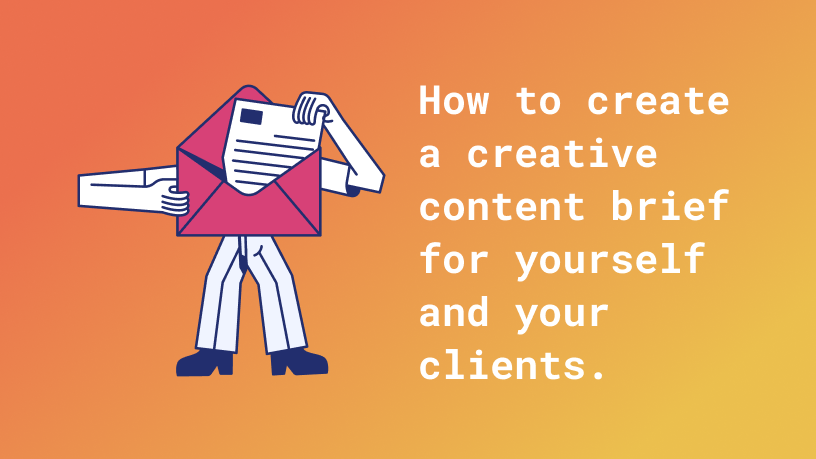Have you ever had to rewrite an article because it didn’t meet your client’s expectations? If yes, then chances are you didn’t use a creative content brief to agree on the desired outcome of the article.
And I admit it – I, too, didn’t use it for a long time.
However, after successfully completing more writing projects than I can count with the document, I never want to work without one again.
A creative content brief is essential for any content writer, especially for client work. It helps you define the angle, goals, and other foundational points to build upon and communicate them to your client. By doing so, you can make sure that you and your client are on the same page before you commit to your ideas and start writing.
In this article, we’ll explore how to create a creative content brief, empowering you to deliver compelling content that hits all the marks and makes your clients happy.
What’s a creative content brief?
A creative brief is a document you create before writing your content. It helps you define your target audience, goals, objectives, and expectations. By doing this, you gain a better understanding of what you want to achieve and can evaluate if you’re on the right track.
Another reason why you create a creative content brief is to ensure that you and your client have the same understanding of what to expect from the finished content before you start writing. Otherwise, you may end up wasting your time.
So, it also provides a bit of security for you and your client, and who doesn’t want to feel safe?
Let’s make this idea more straightforward with an example:
Imagine a client wants you to write a blog post about “going from senior developer to dev team lead.” Without further information, you may have a different idea of what the content should cover.
You may focus on the skills necessary to level up from a senior developer to a managing position. At the same time, your client may want you to write a detailed guide on what to expect in a managing role and how to prepare for it in a senior dev position. Even though both ideas are somewhat similar and both fit the working title provided by the client, the finished content may be lacking and not fulfill the client’s expectations.
As a result, the client may ask you to rewrite the article, which means you have to put in more time and effort.
So, by investing a bit of time before you write anything into establishing a shared picture of the end result with your client, you can save yourself time and get satisfaction points from your client!
Creative content brief best practices
Creating a creative content brief serves as the foundation for your content piece. To achieve this, you need to ask and answer the right questions!
Here are some points to keep in mind when creating a content brief:
Keep it brief!
Avoid writing lengthy prose and instead opt for lists and keywords. The document should be easy to read and understand in a short amount of time.
Create templates
Naturally, depending on the content type and topic, the questions asked in the document may vary. Therefore, create multiple templates for typical content pieces or a template for each new client that includes the needed questions.
Be insistent
Your client’s not up for creating and reviewing a content brief? Explain why it is valuable for them, their goals, and their users (readers). If they still want to skip it, create the content brief anyway and share it with them (even if you can’t bill it). Agree with them that you’ll create content according to what’s defined in the briefing document. This way, if they’re unhappy with the result, you have the back support from the brief! (maybe they then see the value in creating and working with a creative content brief!)
One question at a time
Ask simple questions and only one at a time to keep things simple. Avoid asking multiple questions in one, which can lead to poor answers.
Typical questions to include in your content brief
Here are some questions and points I use in my content briefs. Feel free to adapt them to your needs!
Working title
This could be the title the client communicated to you or the one you came up with yourself. It is only a draft and should give a rough idea of the content.
Target audience(s)
Who are you writing this content for? Generally, you should have one primary audience and maybe a secondary and tertiary audience. This will help you determine the tone and voice of your writing, how you deliver content, and what angle you choose to approach your topic from. For example, if you’re writing about AWS, you probably take different routes when writing for developers than when writing for CTOs.
SEO keywords (primary, secondary)
Estimated length
What’s this blog post about? (max 200 word summary)
Provide a short description of the blog post. I like to write this one in prose and often use and adapt it later when I write the content’s introductory section.
What problem are you solving and why?
Every piece of content you create should address a specific problem that your target audience is facing. It’s essential that you understand why solving this problem is beneficial for your readers (and ideally for the client as well). This will help you create relevant, valuable content that meets your audience’s needs.
How are you solving the problem?
When writing content for a client, you need to keep the reader’s problem in mind and offer a solution related to the client’s service or product. You can add a list of steps to your briefing document to outline how you will solve the problem.
What’s the value/benefit of solving the problem?
Put yourself in the shoes of your readers and client to understand their interest in solving the problem and how it benefits them.
How does the topic relate to the client?
If it still needs to be clarified, explain how the client and the topic are related and why the client is in a great position to write about it or provide assistance.
What are the key takeaways?
Depending on the length and type of your content, it should have one or more key takeaways. What should the reader take away from reading your content piece? Later, when you write your draft, the points defined here will be the most critical parts of your content.
What is the goal of the article?
It’s important to have a clear understanding of the purpose of the content. While it should have a primary objective, you can also include secondary goals. The objective could be to “inform readers about a new product feature” or to “encourage readers to subscribe to our newsletter”.
Inspiration and references
I also like to include links to studies and surveys that I want to include or reference in the content. Additionally, if I come across other content pieces that are related to the topic and are presented well, I include them too. These can be from the client or from other companies.
Conclusion
Now it’s your turn! Try creating content brief templates for different types of content you write. Once you have your templates, use them for every new piece of content you create. Fill it out and send it to your client for feedback. Explicitly ask for their approval before you start writing to ensure that both you and the client have the same understanding of the desired outcome.
This way, you and your client can be sure what the end result should look like and not just hope that everything works out as expected 😉




No responses yet